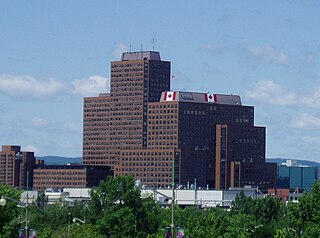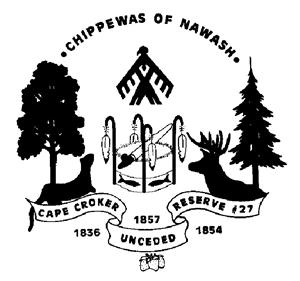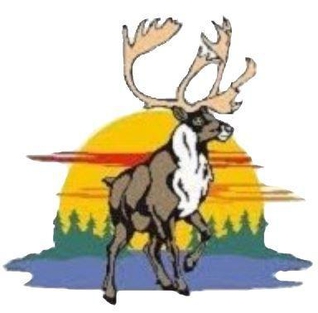
The Cree are a North American Indigenous people. They live primarily in Canada, where they form one of the country's largest First Nations.

The Ojibwe, Ojibwa, Chippewa, or Saulteaux are an Anishinaabe people in what is currently southern Canada, the northern Midwestern United States, and Northern Plains. They are Indigenous peoples of the Subarctic and Northeastern Woodlands.

The Chipewyan are a Dene Indigenous Canadian people of the Athabaskan language family, whose ancestors are identified with the Taltheilei Shale archaeological tradition. They are part of the Northern Athabascan group of peoples, and come from what is now Western Canada.
In Canada, an Indian reserve is defined by the Indian Act as a "tract of land, the legal title to which is vested in His Majesty, that has been set apart by His Majesty for the use and benefit of a band." Reserves are areas set aside for First Nations, one of the major groupings of Indigenous peoples in Canada, after a contract with the Canadian state, and are not to be confused with indigenous peoples' claims to ancestral lands under Aboriginal title.

The Chippewas of Georgina Island First Nation are an Ojibwa people located on Georgina Island in Lake Simcoe, Ontario, Canada. In 2008, of the First Nation's registered population of 666 people, 181 lived on, and 485 lived outside, their reserve. As of 2020, the band has a total population of 923 members. They are one of a handful of First Nations in the Toronto Census Metropolitan Area.

Crown–Indigenous Relations and Northern Affairs Canada is the department of the Government of Canada responsible for Canada's northern lands and territories, and one of two departments with responsibility for policies relating to Indigenous peoples in Canada.

The Wiikwemkoong First Nation is a First Nation on Manitoulin Island in Northern Ontario. The Wiikwemkoong Unceded Territory is the First Nation reserve in the northeast of Manitoulin Island in Manitoulin District, Ontario, Canada. Wiikwemkoong is an unceded Indigenous reserve in Canada, which means that it has not "relinquished title to its land to the government by treaty or otherwise."
The Robinson Treaties are two treaties signed between the Ojibwa chiefs and the Crown in 1850 in the Province of Canada. The first treaty involved Ojibwa chiefs along the north shore of Lake Superior, and is known as the Robinson Superior Treaty. The second treaty, signed two days later, included Ojibwa chiefs from along the eastern and northern shores of Lake Huron, and is known as the Robinson Huron Treaty. The Wiikwemkoong First Nation did not sign either treaty, and their land is considered "unceded".

Chippewas of Nawash Unceded First Nation is an Anishinaabek First Nation from the Bruce Peninsula region in Ontario, Canada. Along with the Saugeen First Nation, they form the Saugeen Ojibway Nation. The Chippewas of Nawash Unceded First Nation had a registered membership of 2758 individuals, as of December 2020. Approximately 700 members live on the main reserve, Neyaashiinigmiing 27. The First Nation has 3 reserves, Neyaashiinigmiing 27, Cape Croker Hunting Ground 60B and Saugeen and Cape Croker Fishing Islands 1. The size of all reserves is 8083.70 hectares.
The Tseycum First Nation is a First Nations government located on Vancouver Island. In the 1850s they were signatories to the Douglas Treaties.
The following is an alphabetical list of topics related to Indigenous peoples in Canada, comprising the First Nations, Inuit and Métis peoples.

Hatchet Lake Denesuline Nation is a Denesuline First Nation in northern Saskatchewan. The main settlement, Wollaston Lake, is an unincorporated community on Wollaston Lake in the boreal forest of north-eastern Saskatchewan, Canada.

The Caldwell First Nation is a First Nations band government whose land base is located in Leamington, Ontario, Canada. They are an Anishinaabe group, part of the Three Fires Confederacy, comprising the bands Potawatomi, Odawa, and Ojibwa, whose members are originally of the Mikinaak (Turtle) and the Makwa (Bear) dodems. The Caldwell First Nation are a distinct and federally recognized Indian band and used to be referred to by such names as the "Chippewas of Pelee", "Point Pelee Indians" and "Caldwell's band of Indians."
Chippewas of Georgina Island First Nation 33A is a First Nations reserve near the shores of Lake Simcoe. It is one of three reserves of the Chippewas of Georgina Island First Nation. It is an enclave within Georgina, Ontario, surrounded by the unincorporated community of Virginia Beach. It is separated from the mainland portion of the Chippewas of Georgina Island First Nation reserve by Black River Road and the private properties along it.
Saugeen and Cape Croker Fishing Islands 1 is a First Nations reserve consisting of 89 islands in Lake Huron off the western coast of the Bruce Peninsula in Ontario. They extend north of Chief's Point 28 for 11 miles (18 km) up to Pike Bay. These islands are shared between the Chippewas of Nawash Unceded First Nation and Saugeen First Nation.

The minister of Indigenous services is a minister of the Crown in the Canadian Cabinet. The minister is responsible for Indigenous Services Canada (ISC), the department of the Government of Canada which delivers federal government services to Indigenous peoples.

The Yellowknives Dene First Nation is a band government in the Northwest Territories. It represents the Yellowknives people, namesake of the territorial capital Yellowknife. Its membership primarily resides in two communities: Ndilǫ, bordering the City of Yellowknife at the tip of Latham Island, and Dettah, separated from the city by Yellowknife Bay.

Land Back is a decentralised campaign by Native Americans in the United States and Indigenous peoples in Canada and allies alike, that seeks to reestablish Indigenous sovereignty, with political and economic control of their ancestral lands. Activists have also used the Land Back framework in Mexico, and scholars have applied it in New Zealand and Fiji. Land Back is part of a broader Indigenous struggle for decolonisation.
In Canada, First Nations communities have been under long-term drinking water advisories (DWAs) for decades. A long-term drinking water advisory is an advisory that has been in place for over a year.











